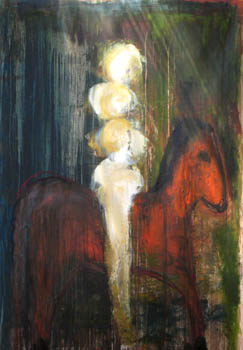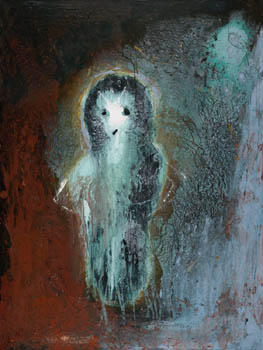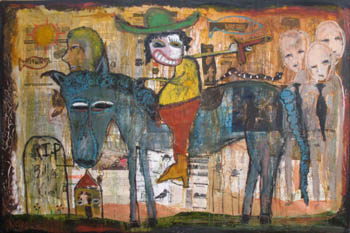sometime after
my family left the farm
got away from living off the land
working with the animals
the old storys stopped being tould
although i still remember
my grandfathers taleing long storys
by the time i was growing up
i was the first generation in my family
completely cut off from that
story taleing culture
and so
all that had guided and led
the men and women in my family
was now becoming lost and it was a
new world my generation would walk thru
without the storys and landmarks
to guide us

book of knowledge
a painting i did on a board i found
Folklore is the body of expressive culture, including tales, music, dance, legends, oral history, proverbs, jokes, popular beliefs, customs, and so forth within a particular population comprising the traditions (including oral traditions) of that culture, subculture, or group. It is also the set of practices through which those expressive genres are shared. The academic and usually ethnographic study of folklore is sometimes called folkloristics. The word 'folklore' was first used by the English antiquarian William Thoms in a letter published by the London Journal Athenaeum in 1846.[1]

Returning on a Red Horse
nother painting i did in 2008
Arkansas Traverler
retold by
S. E. Schlosser
One rainy autumn, a traveler got lost in the mountains of Arkansas.
He was tired and hungry, and so was his horse. Night was approaching. All at once, he saw a cabin. A squatter sat on the porch fiddling the same tune over and over.
The traveler asked the squatter for food and water for himself and his horse. The squatter replied: "Ain't got a thing in the house."
The traveler asked where the next house was. The squatter said: "Dunno. I ain't never been there."
The frustrated traveler asked if he could spend the night. The squatter replied: "House leaks. My wife and me sleep on the only dry spot."
"Why don't you mend the roof?" asked the traveler.
"Can't mend the roof on a rainy day."
The whole time, the squatter continued to fiddle the same tune, over and over.
The traveler snapped: "Why don't you finish that tune?"
"Can't get the turn of the tune."
The traveler took the fiddle, played the turn of the tune and finished it.
"Stranger," said the squatter, "Grab yerself a chair and set down. Sal, cut a hunk outta that deer and cook it. Son, get the whisky and put the horse in the shed. You jest play away, stranger. Tonight, you can sleep on the dry spot!"

Spirit...a painting i did in 2006
The Fairview Ghost
retold by Phillip Steele
We often assume that any folktale is an old story. This is not necessarily true, as the following tale illustrates.
Fairview Cemetery is located on State Highway 45 near the east side of Fayetteville Arkansas. A few years ago several drivers reported seeing a ghost running thru the cemetery as they drove by late at night. These reports continued for almost a year and most of Fayetteville citizens were aware of them.
One night a teen age boy was driving his girl friend home when his car had a blowout as he passed the cemetery. Both young people were aware of the ghost stories and were, as migh be expected, uneasy about having to stop at that place. The girl stayed in the car while the young man hurriedly began changing the tire. Just as he was finishing the girl screamed that she saw the ghost.
The boy gathered up his tools quickly and looked toward the cemetery. He noticed a white figure slowly walking towards the care from one of the monuments.Throwing the tools into the trunk, the boy jumped behind the steering wheel and tried to race away. But a moment before the car started, both teen agers heard the back door of the car open. Someone or something got in and closed the door.
Needless to say the couples fear had by this time turned into panic. and neither was able to look behind them. The boy floored the accelerator and raced towards Fayetteville at top speed. He pulled into a well it service station, where he and the girl jumped out of the car leaving both doors open and the motor running. They ran to the station attendent and exclaimed, "theres a ghost in our backseat!"
At first the attendent thought the couple were trying to play some sort of trick on him, or perhaps that they were attempting a robbery. But soon, realizing that their fear was genuine, he took a revolover from his desk drawer and slowly approached the car. Jerking the door open with pistol in hand, he was shocked to find an old, white haired woman wrapped in a bed sheet lying on the seat, shivering from the cold night air.
The city police were called in and the old lady was taken to a hospital to spend the night. The next day her identity was learned and the explanation of the Fairview Ghost was revealed.
It seems that the lady was living in her daughters home near the cemetery. The lady , who was somewhat deranged, began leaving the house at night, after her daughter and son in law had retired. She then went into the cemetery and sat by her husbands grave. The daughter, afraid her aged mother would become ill from exposure to the night air, began locking the old woman in her room at night. She also removed all of her mothers clothing.
This arrangement worked for several weeks, but soon the old lady learned that she could get out through the window. Wrapping herself in sheets from her bed, she once more began her nighttime excursions to her husbands grave. Thus the Fairview Ghost was born, and a new Ozark tale created..

sheriff fleas the three grey men
painting i did in 2008
Hillbilly from teh wiki
The origins of the term "hillbilly" are obscure. According to Anthony Harkins in Hillbilly: A Cultural History of an American Icon, the term first appeared in print in a 1900 New York Journal article, with the definition: "a Hill-Billie is a free and untrammeled white citizen of Alabama, who lives in the hills, has no means to speak of, dresses as he can, talks as he pleases, drinks whiskey when he gets it, and fires off his revolver as the fancy takes him."
The Appalachian region was largely settled in the 1700s by the Scotch-Irish, the majority of whom originated in the lowlands of Scotland. Harkins believes the most credible theory of the term's origin is that it derives from the linkage of two older Scottish expressions, "hill-folk" and "billie" which was a synonym for "fellow", similar to "guy" or "bloke".
Although the term is not documented until 1900, there have been many conjectural etymologies for the term, including:
- The term originated in 17th century Ireland for Protestant supporters of King William of Orange.[citation needed] Roman Catholic King James II landed at Kinsale in Ireland in 1689 and began to raise a Catholic army in an attempt to regain the British throne. Protestant King William III, Prince of Orange, led an English counterforce into Ireland and defeated James II at the Battle of the Boyne in 1690. A significant portion of William III's army was composed of Protestants of Scottish descent (Planters) who had been settled on land confiscated from Catholics in Ulster, the northernmost of the four provinces of Ireland. The southern Irish Catholic supporters of James II referred to these northern Protestant supporters of King William as Billy Boys[citation needed] — Billy being an abbreviation of William.